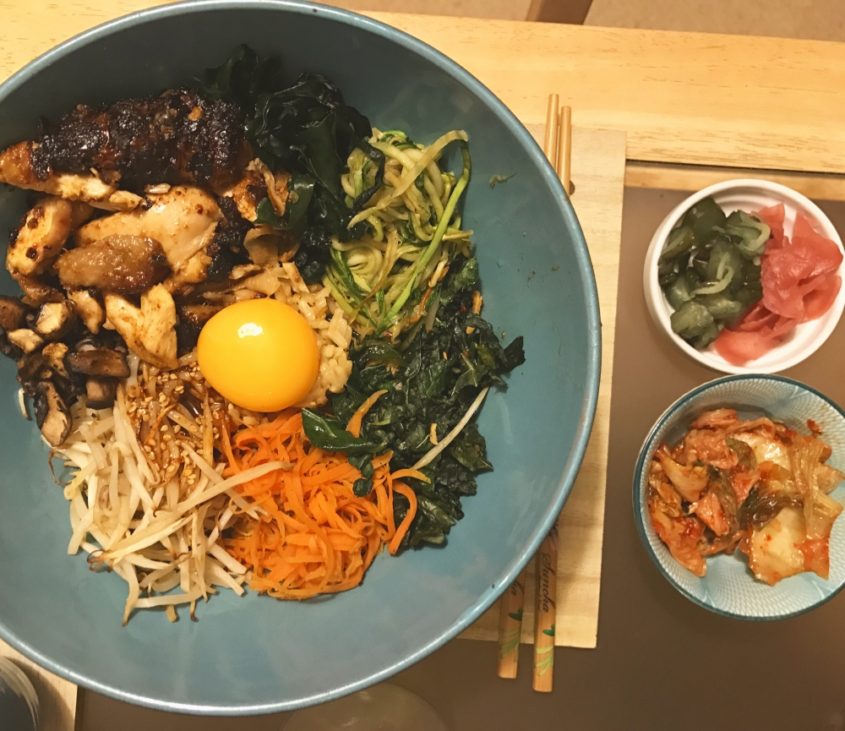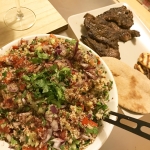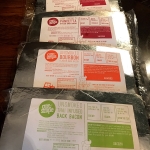Gochujang and peanut butter chicken thigh ingredients
- 3 teaspoons peanut butter
- 3 teaspoons gochujang chilli paste (I got mine from Waitrose)
- 6 teaspoons light soy sauce
- 3 teaspoons water
- 1 teaspoon Korean red pepper flakes
- 3 teaspoons rice wine or white wine vinegar
- 2 cloves garlic chopped or grated
- 750g chicken thighs deboned
Bibimbap ingredients
- 200g uncooked wholegrain rice
- 1 courgette julienned
- 2 carrots julienned
- 8 black kale leaves trimmed from the tough stalk
- 8 chestnut or shitake mushrooms
- handfull of beansprouts
- handfull of dried seaweed soaked in water to re-hydrate
- 2 tablespoons saesame oil
- 3 teaspoons light soy sauce
- 2 teaspoons Gochujang chilli paste
- 1 teaspoon saesame seeds
- 2 egg yolks
Sides
- Kimchi
- Pickled daikon
- Pickled Korean Cucumber
The above 3 were store bought at a Korean deli on Woodfield Road in Cardiff.
Instructions
combine all the gochujang and peanut butter ingredients in a bowl apart from the chicken and red pepper flakes. Mix to combine then add the chicken thighs and massage the marinade into the chicken to coat evenly then cover and put in the fridge for a few hours for the flavours to develop.
Once you’re ready to cook, put the rice in salted water and cook to instructions on the packet. Mine took 25 minutes so I put them in just before the chicken so it was cooked in time but adjust accordingly so everything is done on time.
Place the chicken skin side up on a grill rack, dust with the Korean red pepper flakes and put in a preheated oven at 200C for around 25-30 minutes as the bone is removed and it will take less time than normall for thighs.
Now fry each individual veg seperately for a couple of minutes with a bit of oil and season with salt to cook slightly but you still want a bit of bite as most of it can be eaten raw anyway. When each veg is done assemble them on a large plate or dish keeping them seperated from each other.
Make the gochujang sauce by combining the 2 teaspoons paste, 3 teaspoons soy, 2 tablespoons seasame oil and the saesame seeds in a bowl and mix to combine.
A bibimbap is traditionally served in a clay pot heated up on a stove or in the oven. The pot is heated up extremely hot, coated inside with saesame oil so the rice doesn’t stick then layered with the rice so it starts to crackle and produce a delicious crust on the outside where it comes into contact with the pot.
I didn’t have a clay pot and nothing safe to heat on the stove so I put a ceramic bowl in the oven to warm up coated in oil, added the rice and put in the oven for 5 minutes to heat up.
Then I assembled each of the veg going clockwise on top of the boiling hot rice, chopped the chicken and added on top, dropped the egg yolk in the middle, a dollop of the gochujang sauce depending on your preference but this is more of a sweet and warm spice rather than blow your head off Sriracha chilli sauce.
Once your work of art is assembled, mix with a spoon or chopsticks so all the flavours are combined and the egg cooks in the heat of the rice.
No Korean dish is complete without a side of Kimchi and is ramped up with a portion or two of pickles such as daikon and cucumber.




Leave a Reply
Want to join the discussion?Feel free to contribute!